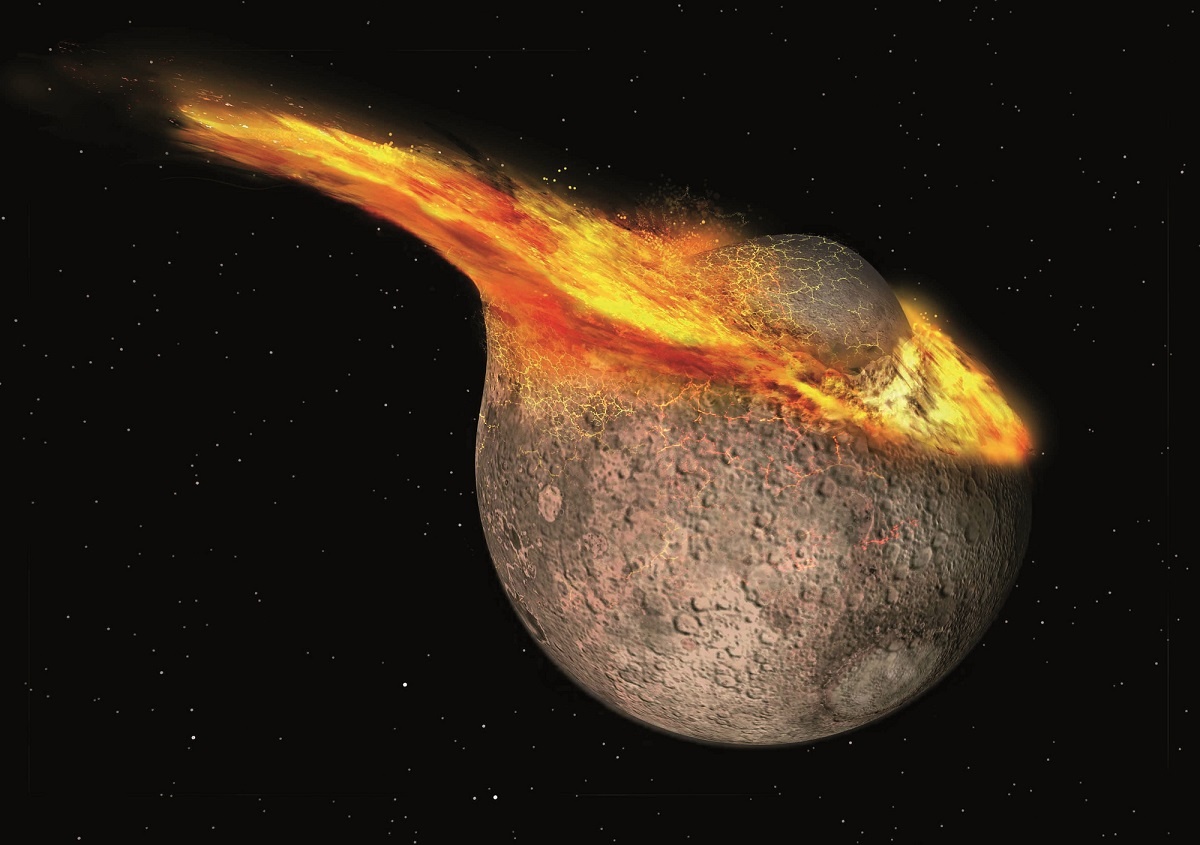According to the Giant Impact Hypothesis, the Moon formed when a Mars-sized object (named Theia) collided with Earth billion years ago, at a time when the Earth was still a ball of magma. This event not only led to the Earth-Moon system we recognize today, it is also beleived to have led to the differentiation of the Earth’s core region into an molten Outer Core and a solid Inner Core.
However, there has been an ongoing debate as to the timing of this impact and how long the subsequent formation of the Moon took place. According to a new study by a team of German researchers, the Moon formed from a magma ocean that took up to 200 million years to solidify. This means that the Moon finished forming about 4.425 billion years ago, or 100 million years later than previously thought.
The study, which recently appeared in the journal Science Advances (titled “A long-lived magma ocean on a young Moon“), was conducted by planetary geophysicists from the German Aerospace Center (DLR), along with researchers from the Technical University of Berlin and the Institute of Planetology at the University of Münster.
When Earth was still in the process of forming roughly four-and-a-half billion years ago, the Solar System was a rather chaotic place. At the time, planetesimals that had also formed from the protoplanetary disk were tossed about and would occasionally collide with a planet. In Earth’s case, this had the effect of adding to its mass and causing its core region to become denser and hotter.
Over time, heavier elements sunk to the center of the Earth, leading to the formation of its iron-nickel core. At the same time, increasingly large parts of the Earth’s mantle melted to form a magma ocean. When Theia collided with Earth, this ocean became several thousands of kilometers deep and much of it was expelled into space. This material either was then reabsorbed by Earth or coalesced in orbit around it to form the Moon.
While most scientists today believe that this is an accurate scenario for how the Moon formed, there has been disagreement about the details and timing of the process. As Maxime Maurice, a researcher with the DLR and the lead author on the study, said:
“The results of our latest modelling suggest that the young Earth was hit by a protoplanet some 140 million years after the birth of the Solar System 4.567 billion years ago. According to our calculations, this happened 4.425 billion years ago – with an uncertainty of 25 million years – and the Moon was born.”

One of the reasons there has been disagreement over the Grand Impact Hypothesis has to do with the very thing that inspired it in the first place: Moon rocks. Basically, of all the Moon rocks brought back to Earth by the six Apollo missions and the three Soviet Luna landers, none provide a direct record of the Moon’s age. As a result, scientists have had to rely on indirect methods for coming up with lunar age estimates.
In addition, the energy gained by the accretion of material also led to the formation of a magma ocean on the Moon, which covered the entire surface and was over 1000 km (620 mi) deep at the time. Also like Earth, this magma ocean began to quickly cool and crystallize to form a crust, which had the effect of insulating the magma beneath it and slowing down the cooling process.
Until now, scientists were unable to determine how long it took for the magma ocean to crystallize completely, which made determining when the Moon originally formed tricky. To arrive at their estimates, Maurice and his colleagues used a new computer model that comprehensively considered the processes involved in the solidification of the magma – similar to what did Maurice (though in greater detail) for his Ph.D. thesis.
This consisted of calculating how the composition of silicate minerals in the Moon’s crust that are rich in magnesium and iron (which formed during the solidification of the magma) changed over time. What they found was evidence that as solidification progressed, there was a drastic change in the composition of the remaining magma ocean.

This finding allowed the team to link the formation of different types of rock on the Moon to a certain stage in the solidification process. Ultimately, this led them to conclude that the Moon’s magma ocean took almost 200 million years before it fully solidified to form the Moon’s crust. This contradicts what scientists previously thought, which was that it took only 35 million years to solidify.
As Sabrina Schwinger, a researcher with the DLR and a co-author on the study, summarized:
“By comparing the measured composition of the Moon’s rocks with the predicted composition of the magma ocean from our model, we were able to trace the evolution of the ocean back to its starting point, the time at which the Moon was formed.”
Last, but not least, the results of this study are consistent with previous age estimates obtained with the uranium-lead method. Based on the rate at which uranium decays to become lead, scientists found that the Earth’s metallic core completed forming at roughly the same time. Therefore, this study is the first to directly link the age of the Moon to an event that occurred at the very end of the Earth’s formation.
As always, determining how one body in the Solar System formed can shed light on how the others did as well. And when it comes to the Earth-Moon system, the origins of one are inextricably tied up with the other.
Further Reading: DLR, Science Advances

